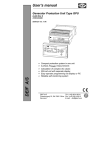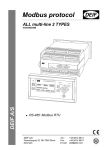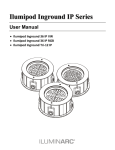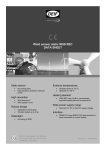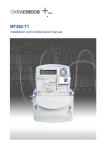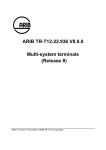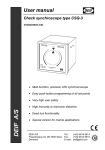Download Paralleling and Protection Unit
Transcript
User’s manual Paralleling and Protection Unit Type PPU multi-line 2 4189340230E Software ver. 1.4X DEIF A/S • Compact system in one unit - dynamic synchronisation - load sharing - generator protection • 3-phase ACRMS measurements • • • • Calculation of complex AC values DIN-rail unit with separate display Easy operator programming via display or PC Reliable self-monitoring system DEIF A/S Tel.: (+45) 9614 9614 Frisenborgvej 33, DK-7800 Skive Fax: (+45) 9614 9615 Denmark E-mail: [email protected] PPU – User’s manual This document is the user’s manual for the standard Deif Multi-line 2 PPU. INDEX: WARNINGS AND LEGAL INFORMATION ...................................................................................... 5 STANDARD FUNCTIONS ................................................................................................................. 5 LANGUAGE ...................................................................................................................................... 5 CONTROL FUNCTIONS ...................................................................................................................... 5 GENERATOR PROTECTION FUNCTIONS ............................................................................................. 6 OPTIONS............................................................................................................................................ 6 HARDWARE ...................................................................................................................................... 7 TERMINAL STRIP OVERVIEW ........................................................................................................ 9 SLOTS 1,2,5 AND 6.......................................................................................................................... 9 SLOTS 3,4 AND 8........................................................................................................................... 10 TERMINAL STRIP, EXPLANATION............................................................................................... 11 SLOT #1, POWER SUPPLY AND BINARY I/O..................................................................................... 11 Inputs ...................................................................................................................................... 12 Alarm relays............................................................................................................................ 13 Status relay, slot #1................................................................................................................ 13 kWh and kvarh counter .......................................................................................................... 13 SLOT #2, SERIAL COMMUNICATION (OPTION H) ............................................................................. 14 CAN-open (Option H1):.......................................................................................................... 14 MOD-bus (Option H2): ........................................................................................................... 14 SLOT #3, LOAD SHARING CONTROL ................................................................................................ 15 Deload input ........................................................................................................................... 16 SLOT #4, A NALOG SPEED GOVERNOR / AVR (OPTION E)............................................................... 18 SLOT #5, AC MEASURING ............................................................................................................. 19 SLOT #6, ANALOGUE TRANSDUCER OUTPUT (OPTION F1)/(SLOT #4 (OPTION F2)).......................... 20 SLOT #8, AVR VOLTAGE CONTROL RELAY OUTPUTS (OPTION D) ................................................... 20 WIRINGS .......................................................................................................................................... 21 AC CONNECTIONS ......................................................................................................................... 21 LOAD SHARING LINES..................................................................................................................... 22 BINARY INPUTS .............................................................................................................................. 22 ANALOGUE INPUTS (EXTERNAL SET- POINTS) .................................................................................. 23 0…10 VDC input using potentiometer:.................................................................................. 23 +/- 10 V input using potentiometer: ....................................................................................... 23 OPTOCOUPLER OUTPUTS FOR EXTERNAL COUNTER ....................................................................... 24 DISPLAY I/F CABLE (OPTION J) ...................................................................................................... 24 PC I/F CABLE (OPTION J3) ............................................................................................................ 25 DISPLAY UNIT................................................................................................................................. 25 PUSH-BUTTON FUNCTIONS ............................................................................................................ 26 4189340230E Page 2/54 PPU – User’s manual DISPLAY FUNCTIONS ...................................................................................................................... 27 First line in display (daily use display functions) ................................................................... 27 Second line in display (daily use display).............................................................................. 27 Second line in display (menu system)................................................................................... 28 Second line in display (alarm and event list)......................................................................... 28 Third line in display (daily use display).................................................................................. 28 Third line in display (parameter menu display) ..................................................................... 28 Fourth line in display (daily use display) ............................................................................... 28 Fourth line in display (parameter menu display) ................................................................... 28 MENU OVERVIEW .......................................................................................................................... 29 PASSWORD SETTING ..................................................................................................................... 30 SERVICE MENU .............................................................................................................................. 30 NAVIGATING IN THE MENUS ............................................................................................................ 31 Setup menu system ............................................................................................................... 31 MENU SET-POINTS ........................................................................................................................ 32 PROTECTION SETUP ...................................................................................................................... 32 Mains/BUS voltage protection option A or B ......................................................................... 32 Mains/BUS frequency protection option A or B..................................................................... 33 Generator voltage protection options A or B ......................................................................... 34 Generator frequency protection options A and B.................................................................. 35 Generator reverse power protection (standard function)...................................................... 36 Generator overcurrent protection (standard function) .......................................................... 36 Generator overload protection option C ................................................................................ 36 Generator current unbalance protection option C................................................................. 37 Generator voltage unbalance protection option C ................................................................ 37 Generator reactive power import (loss of excitation) protection option C............................ 37 Generator reactive power export (overexcitation) protection option C................................. 38 Loss of mains protection option A ......................................................................................... 38 CONTROL SETUP ........................................................................................................................... 39 Synchronisation...................................................................................................................... 39 Blackout closing of breaker.................................................................................................... 39 General failure (sync. fail) ...................................................................................................... 39 PI controller ............................................................................................................................ 40 Deadband (+/- value) ........................................................................................................ 41 Gain factor ......................................................................................................................... 41 ON-time ............................................................................................................................. 41 Diagrams: Analogue output and output activation time ................................................... 41 Frequency controller .............................................................................................................. 42 Power controller ..................................................................................................................... 42 Power ramp up ....................................................................................................................... 42 Power ramp down .................................................................................................................. 43 Power / frequency control mix factor ..................................................................................... 43 Voltage controller option D .................................................................................................... 43 var controller option D ............................................................................................................ 44 var / voltage control mix factor............................................................................................... 44 Power Factor (PF) controller option D................................................................................... 44 POWER SETUP............................................................................................................................... 45 Load dependent start/stop of next generator option G ......................................................... 45 SYSTEM SETUP.............................................................................................................................. 45 4189340230E Page 3/54 PPU – User’s manual Nominal settings..................................................................................................................... 45 Transformer ............................................................................................................................ 46 Controller settings .................................................................................................................. 46 Communication control enable / disable control (option H) .................................................. 46 External communication control (option H) ........................................................................... 47 External communication control (option H) ........................................................................... 47 Date and time (internal clock) setting .................................................................................... 47 Auto detection of running signal ............................................................................................ 47 Battery undervoltage alarm.................................................................................................... 48 Language................................................................................................................................ 48 ANALOGUE OUTPUT OPTION F1/F2 ................................................................................................ 48 Power (P kW) output .............................................................................................................. 48 Apparent Power (S kVA) output ............................................................................................ 49 Reactive Power (Q kvar) output ............................................................................................ 49 Power factor (PF) output........................................................................................................ 49 Frequency output ................................................................................................................... 49 Voltage output ........................................................................................................................ 50 Current output ........................................................................................................................ 50 USER PASSWORD .......................................................................................................................... 50 SERVICE MENU .............................................................................................................................. 50 GENERAL DATA............................................................................................................................. 51 TECHNICAL SPECIFICATIONS .......................................................................................................... 51 UNIT DIMENSIONS ......................................................................................................................... 53 DISPLAY DIMENSIONS .................................................................................................................... 53 PANEL CUTOUT FOR DISPLAY ......................................................................................................... 54 4189340230E Page 4/54 PPU – User’s manual Warnings and legal information This manual gives guidelines to installation of the DEIF Multi-line 2 generator control and protection units. It is, however, not a complete installation instruction. Therefore, even if terminal numbers are shown in the drawings, the drawings are to be used as guidance only. Installing and operating the Multi-line 2 products implies work with dangerous currents and voltages, and therefore it should be done by qualified personnel only. Care must be taken during installation to protect the terminals against static discharges. Once the unit is installed and connected, these precautions are no longer necessary. DEIF takes no responsibility for operation or installation of the generator set. If there is any doubt about how to install or operate the system on which the Multi-line 2 products are measuring, the company responsible for installation or operation must be contacted. Standard functions The PPU is a control and protection unit for a generator driven by a diesel / gas engine or a turbine. The PPU will carry out all necessary tasks to control and protect a generator, regardless of the use of the generator. This means that the PPU can be used for several application types such as: Stand-alone generator Multiple generator load sharing control Fixed load to mains / base load The PPU measuring system is true RMS 3-phase measurement of generator voltage, generator current and BUS (mains) voltage. Language English, German, French or Spanish language may be chosen via the system menu structure. Control functions - - Dynamic synchronisation o Frequency matching o Voltage check o Breaker delay time compensation o Check phase sequence Fixed load (base load) running of the generator Fixed frequency running of a stand-alone generator Load sharing between generators with power and frequency control Relay outputs for speed governor and AVR Relay outputs to close / open generator breaker Adjustable ramp up/down of generator load 4189340230E Page 5/54 PPU – User’s manual Generator protection functions - Reverse power Over current (2 levels) Protective functions can be selected to activate one of 4 configurable relays. Options Option A and option B cannot be chosen at the same time as some functions are common for both. Option A A1 A2 A3 B B1 C C1 D D1 D2 E E1 F F1 F2 1 Description Loss of mains protection package - Over- and under voltage (generator and busbar) - Over- and under frequency (generator and busbar) - Vector jump - Df/dt (ROCOF) - Over- and under voltage (generator and busbar) - Over- and under frequency (generator and busbar) - Df/dt (ROCOF) - Over- and under voltage (generator and busbar) - Over- and under frequency (generator and busbar) - Vector jump Busbar and generator protection package - Over- and under voltage (generator and busbar) - Over- and under frequency (generator and busbar) Generator add-on protection package - Overload - Current unbalance - Voltage asymmetry - Reactive power (import (excitation loss)/export) Voltage/var/cos ö control Selectable (via binary inputs or (optional) serial interface) functions: - Constant voltage (stand-alone) - Constant reactive power (parallel with mains) - Constant power factor (parallel with mains) - Reactive power sharing (parallel with other generators, island operation) - Constant voltage (stand-alone/synchronisation) Analogue controller outputs - +/-20mA for speed governor - +/-20mA for voltage/var/cos ö control (option D) Analogue transducer output - 2 x analogue transducer output - +/-20mA for selectable AC values - 4 x analogue transducer output - +/-20mA for selectable AC values Not possible if option F2 is selected. 2 Available for GPC PPU Available GPU Now X X X Aug. 2001 X X X Aug. 2001 X X X Now X X X Now X X Now X X Aug. 2001 X X Now X X X X X X 2 Now Now 1 X Not possible if option E is selected. 4189340230E Page 6/54 1 2 X PPU – User’s manual Option G G1 H H1 H2 H3 J J1 J2 J3 K L Z Description Start/stop relay outputs - 2 x relay output for start and stop of other generators, programmable set points and timers Serial communication - CAN-open - Mod-bus - Profi-bus Cables - Display cable with plugs, 3m. UL94 (V1) approved - Display cable with plugs, 6m. UL94 (V1) approved - Serial cable for utility SW com., 3m. UL94 (V1) approv. User’s manual (hard copy) - The manual is enclosed on a CD-Rom Display gasket for IP54 Nominal power > 20MW (free of charge) Available for GPC PPU Available GPU Now X Standard X June 2001 Now Aug. 2001 X X X X X X X X X Now Now Now X X X X X X X X X X X X Now Now X X X X X X Hardware The PPU unit housing is divided into board slot positions, some of which are standard (nonchangeable) and some intended for options. The unit is divided like this: Slot #1: Standard Slot #2: Slot #3: Standard Slot #4: Slot #5: Standard Slot #6: Slot #7: Not used Slot #8: Terminal 1-28 Terminal 29-36 Terminal 37-64 Terminal 65-72 Terminal 73-89 Terminal 90-97 Terminal 98-125 Terminal 126-133 In the standard PPU, the only slots used are as standard slots #1, #3 and #5. Slots #2, #4, #6 and #8 are used for options, slot #7 is not used. Besides the slots, there is an additional board where the communication ports are placed. I.e. RS232 PC service port for the utility software and the display port. NOTE: For slots #1, #3 and #5 only specific boards can be mounted. For slots #2, #4, #6 and #8 the boards are interchangeable. An overview of the terminals can be seen on the next page. 4189340230E Page 7/54 SLOT #5 SLOT #7 3 4 5 6 7 8 9 10 11 12 13 14 98 112 113 114 115 116 117 118 119 120 121 122 123 124 125 85 86 87 88 89 DISPLAY 126 127 128 129 130 131 132 133 90 91 92 93 94 95 96 97 65 66 67 68 69 70 71 72 51 52 53 54 55 56 57 58 59 60 61 62 63 64 Service port 29 30 31 32 33 34 35 36 15 16 17 18 19 20 21 22 23 24 25 26 27 28 79 80 81 82 83 84 99 100 101 102 103 104 105 106 107 108 109 110 111 73 74 75 76 77 78 Po we r Se lf c he ck ok 37 38 39 40 41 42 43 44 45 46 47 48 49 50 2 inh ibit Ala rm SLOT #1 SLOT #3 1 SLOT #6 SLOT #8 SLOT #2 SLOT #4 PPU – User’s manual The slots are positioned in the unit as follows (seen from the top of the unit): 4189340230E Page 8/54 PPU – User’s manual Terminal strip overview Slots 1,2,5 and 6 4189340230E Page 9/54 PPU – User’s manual Slots 3,4 and 8 4189340230E Page 10/54 PPU – User’s manual Terminal strip, explanation For the relay outputs, following terms will be used: NO means Normally Open NC means Normally Closed Com. means common terminal for the relay in question Slot #1, power supply and binary I/O Standard board (always needed): Term Function 1 +24 VDC 2 0 VDC 3 NC 4 Com 5 NO 6 Com. 7 NC 8 NO 9 Com. 10 NC 11 NO 12 Com. 13 NC 14 NO 15 Com. 16 NC 17 NO 18 Com. 19 NC 20 Open collector 1 21 Open collector 2 22 Com. Technical data 24 VDC +20 / - 30 % Description Power supply. Status relay 24V / 1A Relay 1, 250 VAC / 8A Normally closed relay, processor /power supply status supervision Configurable Relay 2, 250 VAC / 8A Configurable Relay 3, 250 VAC / 8A Configurable Relay 4, 250 VAC / 8A Open breaker (De-load) Can be configured for tripping also. Close breaker (synchronising) Relay 5, 250 VAC / 8A Transistor out Transistor out Common 23 24 25 26 27 Digital input 1 Digital input 2 Digital input 3 Digital input 4 Digital input 5 Optocoupler Optocoupler Optocoupler Optocoupler Optocoupler 28 Com Common Pulse output 1, kWh counter Pulse output 2, kvarh counter Common terminal for terminals 21 and 22 Remote alarm inhibit Remote alarm acknowledge Start sync. / control functions Bus communication control Block loss of mains (Vector jump and df/dt (ROCOF) only) (option A) Common for terminals 24 to 27 4189340230E Page 11/54 PPU – User’s manual Inputs The inputs 23-27 on slot #1 are control inputs. Terminal 28 is the common. Input 23: The frequency and voltage alarms can be inhibited according to the table. Breaker Inhibit Generator low f/U Generator high f/U Bus low f/U Bus high f/U OFF ON ACT - ON OFF ACT ACT - ON ACT - OFF ACT ACT ACT ACT ACT = Alarm active. All other alarms are not depending on the breaker status. The alarm inhibit LED on the display is lit when this input is set. To avoid the use of the inhibit input the auto detection of running signal can be used. The channel number is 4110. The auto detection of running signal inhibits generator low frequency and low voltage alarms when the measurements are below 30% of the nominal values. Input 24: All the alarms are acknowledged when this input is activated. This is used for acknowledging alarms by a PLC or by relay logic. All alarms are acknowledged by this input. Input 25: This is the start sync. input. When this is set, the “regulator on” LED on the display is lit, and the multi-line 2 is controlling the speed governor/AVR. This input must be removed if e.g. an alarm condition activates relay 4 (breaker opening) and the regulation must stop. Otherwise the multi-line 2 will synchronise the generator to the bus bar again. When this input is ON, the selected running modes are active. If the input terminal 25 is OFF, all control functions are disabled and the running situation is frozen. This includes terminal 43, deloading. If input 25 and the deload input 43 are set, the generator is running at the nominal frequency. Input 26: This input is used when external communication e.g. MOD-bus is used. Refer to the bus protocols. Input 27: The block loss of mains input is inhibiting the loss of mains protection. This is normally set if closing of generator breakers causes fluctuations and is normally set a few seconds. To indicate that input 27 is set, the alarm inhibit LED on the display is flashing. 4189340230E Page 12/54 PPU – User’s manual Alarm relays 5 relays are mounted in the power supply and binary I/O board in slot #1. Of these 5 relays one is used for closing of the generator breaker (relay 5), and one is used for opening of the generator breaker (relay 4). The relays 1-4 can be configured as alarm relays. This is done in the protection menu, in the control menu and in the system menu. Each alarm can be configured to two outputs, output A and output B. If the alarm function is enabled, an alarm will always be displayed on the multi-line 2. Further you can activate a relay which can be used to control your application. The relay can e.g. be used for alarm systems, dropping of unimportant load or as inputs to a PLC. Since each alarm can be configured to two relays, you can combine the use, e.g. output A to an alarm panel and output B to drop unimportant load. The PPU is controlling the speed governor output and AVR output in protection alarm conditions. This means that if an alarm has been configured to relay 4 (opening of breaker), it will automatically start synchronising immediately. To avoid this situation, the start/sync. input 25 must be removed. In general failure conditions (sync. failure) the regulation stops and the running situation is frozen. Status relay, slot #1 The status relay on the power supply board is a normally closed relay with the purpose of processor and power supply supervision. This relay cannot be configured to any alarms. kWh and kvarh counter The PPU monitors the energy production of each unit and it has pulse-outputs for kWh and kVARh measurement. The number of pulses depends on the nominal output of the generator as follows. Pnom Pnom Pnom < 100 kW 100-1000 kW > 1000 kW 1 pulse/kW 1 pulse/10 kW 1 pulse/100 kW The pulse length is 1 s/pulse. 4189340230E Page 13/54 PPU – User’s manual Slot #2, Serial communication (option H) CAN-open (Option H1): Term. 29 30 31 32 33 34 35 36 Function CAN-H GND CAN-L CAN-H GND CAN-L Not used Not used Description The CAN is based on CAN-open. MOD-bus (Option H2): Term. 29 30 31 32 33 34 35 36 Function DATA + (A) GND DATA - (B) DATA + (A) GND DATA - (B) Not used Not used Description The serial communication line should be terminated with a resistor equal to the cable impedance. Use shielded twisted pair cable. 4189340230E Page 14/54 PPU – User’s manual Slot #3, load sharing control Term. Function Technical data Analogue I/O Common Analogue I/O Analogue input Common Analogue input 37 38 39 40 -5…0…5 VDC Com -5…0…5 VDC -10…0…10 VDC 41 42 Com -10…0…10 VDC 43 44 Binary input 6 Binary input 7 Optocoupler Optocoupler 45 Binary input 8 Optocoupler 46 Binary input 9 Optocoupler 47 Binary input 10 Optocoupler 48 49 50 51 52 53 54 55 56 57 58 59 60 61 62 63 64 Binary input 11 Binary input 12 Binary input 13 Binary input 14 Binary input 15 Binary input 16 Binary input 17 Binary input 18 Com NO Com NO Com NO Com NO Com Optocoupler Optocoupler Optocoupler Optocoupler Optocoupler Optocoupler Optocoupler Optocoupler Common Relay no. 6 250 VAC 8A Relay no. 7 250 VAC 8A Relay no. 8 250 VAC 8A Relay no. 9 250 VAC 8A Description Active load sharing line Common for load sharing lines Reactive load sharing Frequency / Active load set-point. Passive (requires external power supply) Common for terminals 40 and 42 Voltage /var/Power factor/Reactive load set-point. Passive (requires external power supply) De-load (not possible in freq-control mode) Manual raise speed (only active when “start sync. /reg.” is OFF) Manual lower speed (only active when “start sync. /reg.” is OFF) Manual raise voltage (only active when “start sync. /reg.” is OFF) Manual lower voltage (only active when “start sync. /reg.” is OFF) Mode 1 Mode 2 Mode 3 Mode 4 Mode 5 Mode 6 Generator breaker open Generator breaker closed Common for terminals 43 to 55 Engine speed governor: Raise speed Engine speed governor: Lower speed Start signal at high generator load = CC (option G) Stop signal at low generator load = CC (option G) Mode 1-6: These controls are only active when the breaker is closed and the start sync. input is ON. Control selections with mode 1-6 inputs: See page 17. The manual binary inputs can be used when the start/sync. input 25 is not activated. They respond to both relay and analogue outputs. 4189340230E Page 15/54 PPU – User’s manual Deload input The PPU has a deload function which is used when the generator breaker has to be opened with no load. The deload function is primarily used when running parallel with generators or the mains. This function is activated by setting input 43 with a binary signal. Then the deloading is started depending on the running condition. When running in stand-alone mode, it is not possible to deload the generator as there is no other generator to take the load. If the deload input is set, the breaker will be opened instantly in fixed frequency mode. In base load, droop and loadsharing mode the speed of the generator will be decreased. The breaker will not open. When running in parallel, the deload input will still open the breaker instantly in fixed frequency mode. In base load, droop and loadsharing mode the load will be decreased and the breaker will open at a configurable set point. The factory setting is 5% of nominal power. If the deload input is left ON after opening of the breaker, it will prevent resynchronisation. 4189340230E Page 16/54 PPU – User’s manual Power / frequency mode selection Fixed frequency Base load (Fixed Power) Droop Load sharing Mode 1 Mode 2 OFF ON OFF ON OFF OFF ON ON Power / frequency modes Internal set-point External (terminals 40(signal) and 41(gnd)) set-point External set-point values: Mode Input Fixed frequency -10…0…+10 VDC Base load (Fixed Power) 0…10 VDC Droop -10…0…+10 VDC Load sharing -10…0…+10 VDC Voltage/var/power factor mode selection (option D) Fixed voltage Fixed var control Fixed power factor control var sharing Mode 3 OFF Mode 3 ON Value - 5…0…+5 Hz related to nominal frequency 0…100% load related to nominal power - 5…0…+5 Hz related to nominal frequency - 5…0…+ 5Hz related to nominal frequency Mode 4 Mode 5 OFF ON OFF OFF OFF ON ON ON Voltage/var/power factor modes (option D) Internal set-point External (terminals 42(signal) and 41(gnd)) set-point External set-point values: Mode Input Fixed voltage -10…0…+10 VDC Fixed var control 0…10 VDC Fixed power factor 0…+10 VDC control var sharing -10…0…+10 VDC Mode 6 OFF Mode 6 ON Value - 10…0…+10 % related to nominal voltage 0…100% load related to nominal power Cos ϕ 1…0.6 inductive - 10…0…+10 % voltage setting related to nominal voltage External set-point inputs are passive and require an external power source (+/- 10 VDC) 4189340230E Page 17/54 PPU – User’s manual Slot #4, Analog speed governor / AVR (option E) These outputs are active outputs i.e. they use the internal power supply. The outputs are galvanically separated from each other and the rest of the unit. The current outputs can if needed be converted to voltage using a resistor across the terminals (250 Ω will convert the +/- 20 mA into +/- 5 VDC). Term. 65 66 67 68 69 70 71 72 Note 1: Function Not used +/- 20 mA out 0 Not used Not used +/- 20 mA out 0 Not used Description Speed governor set-point output. 1) AVR voltage set-point output. Voltage control set-point to AVR is an option (option D). If the combination of analogue speed governor signals and relay AVR signals is needed, the analogue speed governor signal is taken from slot #4, and the AVR relay outputs are taken from slot #8 relays 10 and 11. 4189340230E Page 18/54 PPU – User’s manual Slot #5, AC measuring Term. 73 74 75 76 77 78 79 80 81 82 83 84 85 86 87 88 89 Note: Function I L1 s1 I L1 s2 I L2 s1 I L2 s2 I L3 s1 I L3 s2 U L1 U L2 U L3 U Neutral U L1 U L2 U L3 Technical description Generator current L1 Description 1/5 A AC input Generator current L2 1/5 A AC input Generator current L3 1/5 A AC input Generator voltage L1 Not used Generator voltage L2 Not used Generator voltage L3 Generator voltage neutral BUS voltage L1 Not used BUS voltage L2 Not used BUS voltage L3 Max. 690 VAC phase - phase value Max. 690 VAC phase - phase value Max. 690 VAC phase - phase value For land-based applications only Max. 690 VAC phase - phase value Max. 690 VAC phase - phase value Max. 690 VAC phase - phase value Current inputs are galvanically separated. Max. 0.3 VA per phase. Voltage measurements are available in 4 levels: 1) 2) 3) 4) 100 to 110 VAC 200 to 240 VAC 380 to 480 VAC 660 to 690 VAC The voltage level is to be defined when ordering, but can be changed onsite for the levels 1-3. The voltage level 4 (660-690 VAC) cannot be changed onsite, but must be defined when ordering. 4189340230E Page 19/54 PPU – User’s manual Slot #6, analogue transducer output (option F1)/(slot #4 (option F2)) These outputs are active outputs i.e. they use the internal power supply. The outputs are galvanically separated from each other and the rest of the unit. The individual output can be selected (in display or via PC programming software) to represent any AC measuring value and related values (e.g. power, power factor, frequency, etc….). For actual selection refer to the channel numbers 4500-4560. Via software selection, the outputs can be selected to be 0…20 mA or 4…20 mA. The current output can if needed be converted to voltage using a resistor across the terminals (250 Ω will convert the 0 - 20 mA into 0 - 5 VDC). The outputs can, by moving a jumper on the board, be selected to be +/- 20 mA if needed. Term. Slot #6 90 91 92 93 94 95 96 97 Function Not used 0 0(4) - 20 mA out Not used Not used 0 0(4) - 20 mA out Not used Description Analogue output, selectable Analogue output, selectable Slot #8, AVR voltage control relay outputs (option D) Term. Slot #8 126 127 128 129 130 131 132 133 Function Technical data Description NO Com NO Com Not used Not used Not used Not used Relay 10 250 VAC, 8A Relay 11 250 VAC, 8A Generator AVR: Raise voltage (Option D only) Generator AVR: Lower voltage (Option D only) 4189340230E Page 20/54 PPU – User’s manual Wirings AC connections BUSBAR L2 L3 L1 N PPU 89 UL3 87 UL2 BUSBAR VOLTAGE 85 UL1 18 BREAKER ON 19 15 BREAKER OFF 16 84 N 83 UL3 81 UL2 GENERATOR VOLTAGE 79 UL1 s2 s1 s2 s1 s2 78 76 I2 75 74 s1 I3 77 73 GENERATOR CURRENT I1 GENERATOR Notes: The neutral line (N) connection is not necessary for correct measurement. 3phase without neutral is also possible. The current transformers ground connection can be on s1 or s2 connection, whichever is preferred. Fuses: 2A slow-blow. 4189340230E Page 21/54 PPU – User’s manual Load sharing lines Even though screened cable is not needed, it is recommended if the cable run is longer than 5 m between units. Binary inputs All binary inputs are 24 VDC bi-directional optocoupler. Typical input is: 4189340230E Page 22/54 PPU – User’s manual Analogue inputs (external set-points) The set-point inputs are passive, i.e. an external power source is needed. This can be an active output from e.g. a PLC, or a potentiometer can be used. 0…10 VDC input using potentiometer: +/- 10 V input using potentiometer: 4189340230E Page 23/54 PPU – User’s manual Optocoupler outputs for external counter The kWh counter (terminals 21-23) and kvarh counter (terminals 21-22) outputs are low-power outputs. For that reason the following circuit must be applied: + 24 VDC EXTERNAL COUNTER 0.5 uF 100V PPU 20(kWh) 22 (COMMON) O VDC Display I/F cable (option J) A standard computer extension cable can be used (9-pole SUB-D male / female plugs) or a cable can be tailored: 2 Wires min 0.22 mm . The cable length is 3m. (option J1) or 6m. (option J2). Cable types: Belden 9540, BICC H8146, Brand Rex BE57540 or equivalent. 4189340230E Page 24/54 PPU – User’s manual PC I/F cable (option J3) A standard computer null-modem cable can be used (9-pole SUB-D female / female plugs) or a cable can be tailored: The cable length is 3m. Display unit The display unit used in multi-line 2 communicates and receives power supply via a 9-pole Sub-D plug. The plug fits directly onto the main unit, so the display can be mounted on the top of the main unit. If the display is to be used as remote display, a standard computer extension cable with male / female plug can be used for the connection. Display dimensions HxWxD = 115 x 220 x 20 mm 4189340230E Page 25/54 PPU – User’s manual Push-button functions There are 10 push-buttons on the display unit with the following functions: INFO: Shifts the display 3 lower lines to show the alarm list (up to 30 alarms can be in the list). JUMP: Enters a menu number selection. All settings have a specific number attached to it. Using the JUMP button enables the user to select and display any setting without navigating all the way through the menus (see later). VIEW: Shifts the upper line displaying. The following values can be shown: 3 generator voltages (phase-to-phase) 3 BUS voltages (phase-to-phase) 3 generator currents Generator power factor and produced power (kW) Generator apparent power (VA) and reactive power (kvar) Generator L1 frequency and voltage BUS L1 frequency and voltage LOG: Shifts the display 3 lower lines to show the event and alarm list : Moves the cursor left for manoeuvring in the menus. : Increases the value of the selected set-point (in the setting menus). In the daily use display it is used for scrolling the second line displaying of generator values. SEL: Is used to select the chosen function (underscored selection in the lower line of the display). : BACK: : Decreases the value of the selected set-point (in the setting menus). In the daily use display it is used for scrolling the second line displaying of generator values. Jumps backwards one step in the menu (to previous display). Moves the cursor right for manoeuvring in the menus. 4189340230E Page 26/54 PPU – User’s manual Display functions First line in display (daily use display functions) The first line is used to display generator and BUS values. Typically the line will show 2 or 3 different values at the same time. The following line values can be seen: - Generator voltage L1 L2 L3 (VAC) - BUS voltage L1 L2 L3 (VAC) - Generator current L1 L2 L3 (A) - Generator Power Factor and active power (kW) - Generator apparent power (kVA) and reactive power (kvar) - Generator L1 frequency (Hz) and voltage (VAC) - BUS L1 frequency (Hz) and voltage (VAC) Second line in display (daily use display) The second line is a service line where various values can be shown. Scrolling is done using the and keys. The values available are: For generator: voltage L1-N (VAC) voltage L2-N (VAC) voltage L3-N (VAC) voltage L1-L2 (VAC) voltage L2-L3 (VAC) voltage L3-L1 (VAC) voltage max. (VAC) voltage min. (VAC) current L1 (A) current L2 (A) current L3 (A) frequency L1 (Hz) frequency L2 (Hz) frequency L3 (Hz) active power (kW) reactive power (kvar) apparent power (kVA) energy counter (kWh) power factor voltage angle between L1-L2 (deg.) voltage angle between L2-L3 (deg.) voltage angle between L3-L1 (deg.) For BUS: voltage L1-N (VAC) voltage L2-N (VAC) voltage L3-N (VAC) voltage L1-L2 (VAC) voltage L2-L3 (VAC) voltage L3-L1 (VAC) voltage max. (VAC) voltage min. (VAC) frequency (Hz) voltage angle between L1-L2 (deg.) frequency deviation (df/dt) (Hz / sec.) voltage angle between generator voltage and BUS voltage (deg.) power supply voltage (VDC) 4189340230E Page 27/54 PPU – User’s manual Second line in display (menu system) When entering the menu system, the second line in the display is used for information about which function (with function identifying number) is chosen. Using the and keys will scroll through the settings. Second line in display (alarm and event list) When selecting the alarm (and event) list, the second line will display the latest alarm / event. Using the and keys will scroll through the list. Third line in display (daily use display) The third line is an indication line. The third line contains an explanation for the lower line selection of setup. Third line in display (parameter menu display) In the parameter menu, the third line indicates the present setting of the function in question, and, if changes are to be made, the max. and min. possible value for the setting. Fourth line in display (daily use display) In the daily use display, the fourth line is the entry selection for the parameter menu. If “SEL” is pressed, the selection of menu indicated with an underscore will be entered. Choices are: “PROT”, protection setup “CTRL”, controls setup “POWER”, power control setup “SYST”, system setup The settings related to the setup can be seen in the paragraph “Menu overview”, where the specific function numbers (related to the “JUMP” function) can be seen. Fourth line in display (parameter menu display) When entering the parameter menus, the first (entry) display uses the fourth line to select a subfunction for the parameter. What the selections are is dependent on the function selected. 4189340230E Page 28/54 PPU – User’s manual Examples: For protective function, the first entry shows the “BUS high volt 1” setting (provided the option is chosen). In this case the fourth line shows: “LIM”, setting of switch point “DEL”, setting of time delay “OA” and “OB”, selection of which relay the function must activate. “ACT”, activate / de-activate the function. For control functions, the first entry shows the “Synchronisation” function. In this case the fourth line shows: “fMax”, max. allowed positive frequency deviation when synchronising. “fMin”, min allowed negative frequency deviation when synchronising. “Umax”, max. allowed voltage deviation (positive or negative) when synchronising. “tCB”, closing time delay for generator circuit breaker. For power setup, the first entry shows the “Start next gen.” relay output (if the option is chosen). In this case the fourth line shows: “LIM”, setting of load dependent start output activation limit. “DEL”, time delay for activating the relay. “ACT”, activate / de-activate the function. Note that no relay selection is present. This is due to the fact that the function relates to a predetermined relay output on slot #3. For system setup, the first entry shows the “Nominal settings”. In this case the fourth line shows: “F”, nominal frequency setting. “P”, nominal generator power setting. “I”, nominal generator current setting. “U”, nominal generator voltage setting. The above settings are used by the PPU to calculate nominal apparent power and current. Menu overview The following is the menu structure when entering settings of the PPU. If no entry has taken place before, the first display to appear is the password display. Enter the factory setting password to gain access to the menus. If no actions have been taken within 3 minutes, the password entry will be de-activated, and a new password entry will be needed. The menu overview is divided according to the daily use display selections in the fourth line (“PROT”, “CTRL”, “POWER”, “SYST”.) 4189340230E Page 29/54 PPU – User’s manual Password setting The password setting falls outside the menu structure and can only be entered via the “JUMP” push-button. Select no. 4976 to enter password setting and select your own password. Use the and the buttons to change the setting and the “SEL” button to store the new setting. Beware: Write down the new password. If you forget it, entering the menus will not be possible. Service menu The service menu falls outside the menu structure and can only be entered via the “JUMP” pushbutton. Select channel 4980 to enter the service menu. 4189340230E Page 30/54 PPU – User’s manual Navigating in the menus The menu navigating starts from the daily use display fourth line and is carried out from there using the “SEL”, , , , and “BACK” push-buttons. Setup menu system The following is an example, but all menus operate in the same manner. Starting from the daily use display fourth line, select the menu indicated with underscore: (move the underscore with the and pushbuttons) PROT CTRL POWER SYST BACK SEL 1010 BUS high-volt 1 Set point 103.0 % 1020 BUS high-volt 2 Set point 105.0 % LIM DEL OA OB ACT LIM DEL OA OB ACT ….ETC. BACK SEL First entry? Yes No Enter passw. 1999 increase no. ENTER 1011 BUS high-volt 1 100.0 103.0 120.0 % RESET SAVE decrease no. increase setting decrease setting and moves the selection (underscore) 4189340230E Page 31/54 PPU – User’s manual Menu set-points The following lists are in numerical order, i.e. the set-points and timers appear according to the given number. Protection setup Mains/BUS voltage protection option A or B Voltage selections relate to nominal phase – to phase voltage No. Setting Min. setting 1010 BUS overvolt 1 Selection display 1011 BUS overvolt 1 Set-point 100.0% 1012 BUS overvolt 1 Time 0.1 s 1013 BUS overvolt 1 Relay output A R0 (None) 1014 BUS overvolt 1 Relay output B R0 (None) 1015 BUS overvolt 1 Enable OFF No. 1020 1021 1022 1023 1024 1025 Setting BUS overvolt 2 BUS overvolt 2 BUS overvolt 2 BUS overvolt 2 BUS overvolt 2 BUS overvolt 2 No. 1030 1031 1032 1033 1034 1035 No. 1040 1041 1042 1043 1044 1045 Max. setting Selection display Set-point Time Relay output A Relay output B Enable Max. setting Selection display Set-point Time Relay output A Relay output B Enable Min. setting 80.0% 0.1 s R0 (None) R0 (None) OFF Max. setting Selection display Set-point Time Relay output A Relay output B Enable Min. setting 80.0% 0.0 s R0 (None) R0 (None) OFF Setting BUS undervolt 2 BUS undervolt 2 BUS undervolt 2 BUS undervolt 2 BUS undervolt 2 BUS undervolt 2 120.0% 100.0 s R4 (relay 4) R4 (relay 4) ON Min. setting 100.0% 0.0 s R0 (None) R0 (None) OFF Setting BUS undervolt 1 BUS undervolt 1 BUS undervolt 1 BUS undervolt 1 BUS undervolt 1 BUS undervolt 1 Max. setting 120.0% 100.0 s R4 (relay 4) R4 (relay 4) ON 100.0% 100.0 s R4 (relay 4) R4 (relay 4) ON 100.0% 100.0 s R4 (relay 4) R4 (relay 4) ON Factory setting 103.0% 10.0 s R2 (relay 2) R0 (None) OFF Factory setting 105.0% 5.0 s R1 (relay 1) R0 (None) OFF Factory setting 97.0% 10.0 s R2 (relay 2) R0 (None) OFF Factory setting 95.0% 5.0 s R1 (relay 1) R0 (None) OFF 4189340230E Page 32/54 PPU – User’s manual Mains/BUS frequency protection option A or B Frequency settings relate to nominal frequency setting. No. Setting 1050 1051 1052 1053 1054 1055 BUS high freq. 1 BUS high freq. 1 BUS high freq. 1 BUS high freq. 1 BUS high freq. 1 BUS high freq. 1 No. 1060 1061 1062 1063 1064 1065 BUS high freq. 2 BUS high freq. 2 BUS high freq. 2 BUS high freq. 2 BUS high freq. 2 BUS high freq. 2 Max. setting Selection display Set-point Time Relay output A Relay output B Enable Min. setting 90.0% 0.1 s R0 (None) R0 (None) OFF Max. setting Selection display Set-point Time Relay output A Relay output B Enable Min. setting 90.0% 0.0 s R0 (None) R0 (None) OFF Setting BUS low freq. 1 BUS low freq. 1 BUS low freq. 1 BUS low freq. 1 BUS low freq. 1 BUS low freq. 1 No. 1080 1081 1082 1083 1084 1085 Max. setting Selection display Set-point Time Relay output A Relay output B Enable Min. setting 100.0% 0.0 s R0 (None) R0 (None) OFF Setting No. 1070 1071 1072 1073 1074 1075 Max. setting Selection display Set-point Time Relay output A Relay output B Enable Min. setting 100.0% 0.1 s R0 (None) R0 (None) OFF Setting BUS low freq. 2 BUS low freq. 2 BUS low freq. 2 BUS low freq. 2 BUS low freq. 2 BUS low freq. 2 110.0% 100.0 s R4 (relay 4) R4 (relay 4) ON 110.0% 100.0 s R4 (relay 4) R4 (relay 4) ON 100.0% 100.0 s R4 (relay 4) R4 (relay 4) ON 100.0% 100.0 s R4 (relay 4) R4 (relay 4) ON Factory setting 103.0% 10.0 s R2 relay 2 R0 (None) OFF Factory setting 105.0% 5.0 s R1 (relay 1) R0 (None) OFF Factory setting 97.0% 10.0 s R2 (relay 2) R0 (None) OFF Factory setting 95.0% 5.0 s R1 (relay 1) R0 (None) OFF 4189340230E Page 33/54 PPU – User’s manual Generator voltage protection options A or B No. 1310 1311 1312 1313 1314 1315 Setting Gen. high volt 1 Gen. high volt 1 Gen. high volt 1 Gen. high volt 1 Gen. high volt 1 Gen. high volt 1 No. 1320 1321 1322 1323 1324 1325 Gen. high volt 2 Gen. high volt 2 Gen. high volt 2 Gen. high volt 2 Gen. high volt 2 Gen. high volt 2 Max. setting Selection display Set-point Delay Relay output A Relay output B Enable Min. setting 80.0% 0.1 s R0 (None) R0 (None) OFF Max. setting Selection display Set-point Delay Relay output A Relay output B Enable Min. setting 80.0% 0.1 s R0 (None) R0 (None) OFF Setting Gen. low volt 1 Gen. low volt 1 Gen. low volt 1 Gen. low volt 1 Gen. low volt 1 Gen. low volt 1 No. 1340 1341 1342 1343 1344 1345 Max. setting Selection display Set-point Delay Relay output A Relay output B Enable Min. setting 100.0% 0.1 s R0 (None) R0 (None) OFF Setting No. 1330 1331 1332 1333 1334 1335 Max. setting Selection display Set-point Delay Relay output A Relay output B Enable Min. setting 100.0% 0.1 s R0 (None) R0 (None) OFF Setting Gen. low volt 2 Gen. low volt 2 Gen. low volt 2 Gen. low volt 2 Gen. low volt 2 Gen. low volt 2 120.0% 100.0 s R4 (relay 4) R4 (relay 4) ON 120.0% 100.0 s R4 (relay 4) R4 (relay 4) ON 100.0% 100.0 s R4 (relay 4) R4 (relay 4) ON 100.0% 100.0 s R4 (relay 4) R4 (relay 4) ON Factory setting 103.0% 10.0 s R2 (relay 2) R0 (None) OFF Factory setting 105.0% 5.0 s R1 (relay 1) R0 (None) OFF Factory setting 97.0% 10.0 s R2 (relay 2) R0 (None) OFF Factory setting 95.0% 5.0 s R1 (relay 1) R0 (None) OFF 4189340230E Page 34/54 PPU – User’s manual Generator frequency protection options A and B No. 1350 1351 1352 1353 1354 1355 Setting Gen. high freq. 1 Gen. high freq. 1 Gen. high freq. 1 Gen. high freq. 1 Gen. high freq. 1 Gen. high freq. 1 No. 1360 1361 1362 1363 1364 1365 Gen. high freq. 2 Gen. high freq. 2 Gen. high freq. 2 Gen. high freq. 2 Gen. high freq. 2 Gen. high freq. 2 Max. setting Selection display Set-point Delay Relay output A Relay output B Enable Min. setting 90.0% 0.2 s R0 (None) R0 (None) OFF Max. setting Selection display Set-point Delay Relay output A Relay output B Enable Min. setting 90.0% 0.2 s R0 (None) R0 (None) OFF Setting Gen. low freq. 1 Gen. low freq. 1 Gen. low freq. 1 Gen. low freq. 1 Gen. low freq. 1 Gen. low freq. 1 No. 1380 1381 1382 1383 1384 1385 Max. setting Selection display Set-point Delay Relay output A Relay output B Enable Min. setting 100.0% 0.2 s R0 (None) R0 (None) OFF Setting No. 1370 1371 1372 1373 1374 1375 Max. setting Selection display Set-point Delay Relay output A Relay output B Enable Min. setting 100.0% 0.2 s R0 (None) R0 (None) OFF Setting Gen. low freq. 2 Gen. low freq. 2 Gen. low freq. 2 Gen. low freq. 2 Gen. low freq. 2 Gen. low freq. 2 110.0% 100.0 s R4 (relay 4) R4 (relay 4) ON 110.0% 100.0 s R4 (relay 4) R4 (relay 4) ON 100.0% 100.0 s R4 (relay 4) R4 (relay 4) ON 100.0% 100.0 s R4 (relay 4) R4 (relay 4) ON Factory setting 103.0% 10.0 s R2 (relay 2) R0 (None) OFF Factory setting 105.0% 5.0 s R1 (relay 1) R0 (None) OFF Factory setting 97.0% 10.0 s R2 (relay 2) R0 (None) OFF Factory setting 95.0% 5.0 s R1 (relay 1) R0 (None) OFF 4189340230E Page 35/54 PPU – User’s manual Generator reverse power protection (standard function) Reverse power settings relate to nominal power setting. No. Setting 1090 1091 1092 1093 1094 1095 Reverse power Reverse power Reverse power Reverse power Reverse power Reverse power Min. setting -50.0% 0.1 s R0 (None) R0 (None) OFF Max. setting Max. setting Selection display Set-point Time Relay output A Relay output B Enable Min. setting 50.0% 0.1 s R0 (None) R0 (None) OFF Max. setting Selection display Set-point Time Relay output A Relay output B Enable Min. setting 50.0% 0.1 s R0 (None) R0 (None) OFF Min. setting 10.0% 0.1 s R0 (None) R0 (None) OFF Max. setting Selection display Set-point Time Relay output A Relay output B Enable 0.0% 100.0 s R4 (relay 4) R4 (relay 4) ON Factory setting -5.0% 10.0 s R1 (relay 1) R0 (None) ON Generator overcurrent protection (standard function) Settings relate to nominal generator current. No. Setting 1100 1101 1102 1103 1104 1105 Overcurrent 1 Overcurrent 1 Overcurrent 1 Overcurrent 1 Overcurrent 1 Overcurrent 1 No. 1110 1111 1112 1113 1114 1115 Setting Overcurrent 2 Overcurrent 2 Overcurrent 2 Overcurrent 2 Overcurrent 2 Overcurrent 2 200.0% 100.0 s R4 (relay 4) R4 (relay 4) ON 200.0% 100.0 s R4 (relay 4) R4 (relay 4) ON Factory setting 115.0% 10.0 s R2 (relay 2) R0 (None) ON Factory setting 120.0% 5.0 s R1 (relay 1) R0 (None) ON Generator overload protection option C Settings relate to nominal power setting. No. Setting 1160 1161 1162 1163 1164 1165 Overload 1 Overload 1 Overload 1 Overload 1 Overload 1 Overload 1 Selection display Set-point Time Relay output A Relay output B Enable 200.0% 100.0 s R4 (relay 4) R4 (relay 4) ON Factory setting 100.0% 10.0 s R2 (relay 2) R0 (None) OFF 4189340230E Page 36/54 PPU – User’s manual No. 1170 1171 1172 1173 1174 1175 Setting Overload 2 Overload 2 Overload 2 Overload 2 Overload 2 Overload 2 Selection display Set-point Time Relay output A Relay output B Enable Min. setting 10.0% 0.1 s R0 (None) R0 (None) OFF Max. setting Min. setting 0.0% 0.1 s R0 (None) R0 (None) OFF Max. setting Min. setting 0.0% 0.1 s R0 (None) R0 (None) OFF Max. setting 200.0% 100.0 s R4 (relay 4) R4 (relay 4) ON Factory setting 110.0% 5.0 s R1 (relay 1) R0 (None) OFF Generator current unbalance protection option C Settings relate to nominal generator current. No. Setting 1220 1221 1222 1223 1224 1225 Current unbalance Current unbalance Current unbalance Current unbalance Current unbalance Current unbalance Selection display Set-point Time Relay output A Relay output B Enable 100.0% 100.0 s R4 (relay 4) R4 (relay 4) ON Factory setting 30.0% 10.0 s R2 (relay 2) R0 (None) OFF Generator voltage unbalance protection option C Settings relate to nominal generator voltage. No. Setting 1230 1231 1232 1233 1234 1235 Voltage unbalance Voltage unbalance Voltage unbalance Voltage unbalance Voltage unbalance Voltage unbalance Selection display Set-point Time Relay output A Relay output B Enable 50.0% 100.0 s R4 (relay 4) R4 (relay 4) ON Factory setting 10.0% 10.0 s R2 (relay 2) R0 (None) OFF Generator reactive power import (loss of excitation) protection option C Settings relate to nominal generator power value (kW). No. Setting 1240 1241 1242 1243 1244 1245 var import var import var import var import var import var import Selection display Set-point Time Relay output A Relay output B Enable Min. setting 0.0% 0.1 s R0 (None) R0 (None) OFF Max. setting 150.0% 100.0 s R4 (relay 4) R4 (relay 4) ON Factory setting 50.0% 10.0 s R1 (relay 1) R0 (None) OFF 4189340230E Page 37/54 PPU – User’s manual Generator reactive power export (overexcitation) protection option C Settings relate to nominal generator power value (kW). No. Setting 1250 1251 1252 1253 1254 1255 var export var export var export var export var export var export Selection display Set-point Time Relay output A Relay output B Enable Min. setting 0.0% 0.1 s R0 (None) R0 (None) OFF Max. setting Min. setting 0.1 Hz/s 1 per R0 (None) R0 (None) OFF Max. setting Min. setting 1.0 deg. Max. setting 100.0% 100.0 s R4 (relay 4) R4 (relay 4) ON Factory setting 60.0% 10.0 s R2 (relay 2) R0 (None) OFF Loss of mains protection option A Df/dt (ROCOF) NOTE: Time delay is in periods (per) No. Setting 1260 1261 1262 1263 1264 1265 Df/dt (ROCOF) Df/dt (ROCOF) Df/dt (ROCOF) Df/dt (ROCOF) Df/dt (ROCOF) Df/dt (ROCOF) Vector Jump No. 1270 1271 1272 1273 1274 1275 Vector jump Vector jump Vector jump Vector jump Vector jump Vector jump Selection display Set-point +/Time Relay output A Relay output B Enable Setting Selection display Set-point Time Relay output A Relay output B Enable 10.0 Hz/s 20 per R4 (relay 4) R4 (relay 4) ON Factory setting 5.0 Hz/s 6 per R1 (relay 1) R0 (None) OFF Factory setting 90.0 deg. 10.0 deg. No delay (immediate trip) R0 (None) R4 (relay 4) R1 (relay 1) R0 (None) R4 (relay 4) R0 (None) OFF ON OFF The alarm inhibit lamp is flashing if the block loss of mains input is set. 4189340230E Page 38/54 PPU – User’s manual Control setup Synchronisation The “dU max.” setting is related to nominal generator voltage. The “dU max.” setting is + nominal generator voltage. No. 2010 2011 2012 2013 2014 Setting Synchronisation Synchronisation Synchronisation Synchronisation Synchronisation Selection display Df max. Df min. DU max. Breaker delay Min. setting 0.0 Hz -0.5 Hz 2% 40 ms Max. setting 0.5 Hz 0.5 Hz 10% 300 ms Factory setting 0.3 Hz 0.0 Hz 5% 50 ms The synchronisation pulse is 400 ms. Blackout closing of breaker Settings are the accepted limits (generator voltage and frequency) for closing the breaker. The “dU max.” setting is related to nominal generator voltage. No. 2020 2021 2022 2023 Setting Sync. blackout Sync. blackout Sync. blackout Sync. blackout Selection display Df max. DU max. Enable Min. setting 0.0 Hz 2% OFF Max. setting 5.0 Hz 10% ON Factory setting 3.0 Hz 5% OFF If blackout closing of breaker is enabled on more units, external precautions must be taken to avoid two or more generators closing on a black busbar. In that case synchronism will not be present. General failure (sync. fail) The general failure covers: Synchronisation time Breaker ON/OFF feedback fail Generator voltage not established Generator frequency not established Phase sequence error 4189340230E Page 39/54 PPU – User’s manual No. 2030 2031 2032 2033 Setting General failure General failure General failure General failure Selection display Delay Relay output A Relay output B Min. setting 0.0 s R0 (none) R0 (none) Max. setting Factory setting 60.0 s R2 (relay 2) R0 (none) 120.0 s R4 (relay 4) R4 (relay 4) The general failure cannot be disabled. PI controller The PPU includes controllers for the different running modes. The controllers control either a relay output (standard slot #3/option D slot #8) or an analogue output (option E slot #4). The basic principle of the controller is that a calculation is being executed every 5 * ON time (relay output) or 5 * integ. time (analogue output). The result of this calculation indicates whether the actual value (e.g. nominal frequency) is within the deadband. In that case there will be no changes on the output. If the actual value is differing from the deadband, the controller will cause an output signal change. If the relay output is used, the relay will be set for a certain time depending on the deviation from the actual value to the desired value. The length of the output signal will be up to 5 * ON time. If the analogue output is used, the analogue signal will change depending on the gain factor and the deviation from the actual value to the desired value. The period the output signal changes will be up to 5 * integral time. After a period of 5 * ON time or 5 * integral time a new calculation is carried out. From the table below it appears what controllers are active in the different running modes. Controllers: Controllers Freq. Fixed freq. Fixed power Droop Loadsharing Fixed voltage Fixed var Fixed PF Loadsharing Power Voltage Mix factor var PF f/P mix U/var mix x x x x x x x x x x x x The mix factors are not controllers, but they indicate the influence of the two controllers in question. 4189340230E Page 40/54 PPU – User’s manual Example: The generator is running in loadshare mode. The f/P mix factor is set to 50%. Now the frequency controller participates with 50% of the governor control and the power controller participates with: 100 – 50 = 50%. When running in the generators, the relevant controller must be set in each desired running mode. (Fixed frequency mode set frequency controller). With the exception of the PF controller the controllers are active in more running modes depending on the application. Regardless of that, the controller values will be the same. Deadband (+/- value) The controllers will find a value within the deadband area. If the actual value is within this area the output signals will not change. When the calculation shows an actual value outside the deadband area, the output signals change again. Gain factor The gain factor indicates with what rate the analogue output signal will change. A higher gain factor will cause a faster regulation, but it might also cause the prime movers to hunt. ON-time The output relay is active for a time of = K * ON time. K is depending on the deviation from nominal value. Diagrams: Analogue output and output activation time f = generator frequency U = analogue output signal f = generator frequency K = konstant The output signal changes: t = K x integral time [ms] 4189340230E Page 41/54 PPU – User’s manual Frequency controller The ON / integral time is a combined setting. If relay speed control setting is used, the setting indicates the shortest relay ON time. If the speed control setting is analogue output (option E), the setting is for the PI controller integral time. Frequency % settings relate to nominal generator frequency. No. Setting Min. setting 2050 Freq. control Selection display 2051 Freq. control Droop 0.0% 2052 Freq. control Dead band 0.2% 2053 Freq. control Gain 1 2054 Freq. control ON / Integr. Time 10 ms Max. setting 10.0% 10.0% 100 3000 ms Factory setting 4.0% 1.0% 40 100 ms Power controller The ON / integral time is a combined setting. If relay speed control setting is used, the setting indicates the shortest relay ON time. If the speed control setting is analogue output (option E), the setting is for the PI controller integral time. Power % settings relates to nominal generator power. No. Setting 2060 2061 2062 2063 Power control Power control Power control Power control Selection display Dead band Gain ON / Integr. Time Min. setting 0.2% 1 10 ms Max. setting 10.0% 100 3000 ms Factory setting 2.0% 40 100 ms Power ramp up The delay point and – time is the point where the generator stops ramping after closing of breaker to pre-heat the engine before commencing to take load. The time duration of the point is determined by the delay time setting. If the delay function is not needed, set the time to 0. Power % settings relate to nominal generator power. No. Setting 2070 2071 2072 2073 Power ramp up Power ramp up Power ramp up Power ramp up Selection display Speed Delay point Delay time Min. setting 1.0%/s 1.0% 0.0 s Max. setting 20.0%/s 100.0% 180.0 s Factory setting 2.0%/s 10.0% 10.0 s 4189340230E Page 42/54 PPU – User’s manual Power ramp down The breaker open point is where a relay output (relay 4) is activated to open the generator breaker before reaching 0 kW. Power % settings relate to nominal generator power. No. Setting 2080 Power ramp down 2081 Power ramp down 2082 Power ramp down Selection display Speed Breaker open Min. setting 1.0%/s 1.0% Max. setting 20.0%/s 20.0% Factory setting 10.0%/s 5.0% Power / frequency control mix factor The mix factor determines the relation between frequency control and power control when running parallel with other generators (load sharing). The reason for the factor is that there is only one power / frequency load sharing line. Setting the factor to 100% selects power control only, setting it to 0% selects frequency control only. No. Setting 2090 P/f contr. mix. 2091 P/f contr. mix. Selection display Mix factor Min. setting 0.0% Max. setting 100.0% Factory setting 50.0% Voltage controller option D The ON / integral time is a combined setting. If relay voltage control setting is used, the setting indicates the shortest relay ON time. If the voltage control setting is analogue output (option E), the setting is for the PI controller integral time. Voltage deadband % settings relate to nominal generator voltage. No. Setting Min. setting 2100 Voltage control Selection display 2101 Voltage control Deadband 0.0% 2102 Voltage control Gain 1 2103 Voltage control ON / Integr. time 10 ms Max. setting 10.0% 100 3000 ms Factory setting 2.0% 40 100 ms 4189340230E Page 43/54 PPU – User’s manual var controller option D The ON / integral time is a combined setting. If relay var control setting is used, the setting indicates the shortest relay ON time. If the var control setting is analogue output (option E), the setting is for the PI controller integral time. var deadband % settings relate to nominal generator power value, i.e. it is assumed that the generator var value is the same as the kW value. This is not correct but the assumption is made for control purposes only. No. 2110 2111 2112 2113 Setting var control var control var control var control Selection display Deadband Gain ON / Integr. Time Min. setting 0.0% 1 10 ms Max. setting 10.0% 100 3000 ms Factory setting 2.0% 40 100 ms var / voltage control mix factor The mix factor determines the relation between voltage control and var control when running parallel with other generators (load sharing). The reason for the factor is that there is only one var / voltage load sharing line. Setting the factor to 100% selects var control only setting it to 0% selects voltage control only. No. Setting 2120 var/U contr. mix. 2121 var/U contr. mix. Selection display Mix factor Min. setting 0.0% Max. setting 100.0% Factory setting 50.0% Power Factor (PF) controller option D The ON / integral time is a combined setting. If relay PF control setting is used, the setting indicates the shortest relay ON time. If the PF control setting is analogue output (option E), the setting is for the PI controller integral time. PF deadband is the zone (+/- value) around PF setting value where the relay output does not operate. The value is disregarded if analogue PF control output is used. No. 2130 2131 2132 2133 Setting PF control PF control PF control PF control Selection display Deadband Gain ON / Integr. Time Min. setting 0.00 1 10 ms Max. setting 0.10 100 3000 ms Factory setting 0.05 40 100 ms 4189340230E Page 44/54 PPU – User’s manual Power setup Load dependent start/stop of next generator option G The relay outputs for start next and stop next are placed in the loadsharing board in slot #3. The PPU cannot decide what generator to start/stop. This must be handled externally. Start next generator: Relay 8, terminals 61-62, normally open. No. 3010 3011 3012 3013 Setting Start next gen. Start next gen. Start next gen. Start next gen. Selection display Start point Timer Enable Min. setting 0.0% 0.0 s OFF Max. setting 150.0% 100.0 s ON Factory setting 80.0% 10.0 s ON Stop next generator: Relay 9, terminals 63-64, normally open. No. 3020 3021 3022 3023 Setting Stop next gen. Stop next gen. Stop next gen. Stop next gen. Max. setting Selection display Stop point Timer Enable Min. setting 0.0% 0.0 s OFF Max. setting Selection display Frequency Generator Power Generator current Generator volt Min. setting 48.0 Hz 10 kW 0A 100 V 50.0% 200.0 s ON Factory setting 20.0% 30.0 s ON System setup Nominal settings No. 4010 4011 4012 4013 4014 Setting Nominal settings Nominal settings Nominal settings Nominal settings Nominal settings 62.0 Hz 99 MW 9000 A 25000 V Factory setting 60.0 Hz 100 kW 787 A 110 V 4189340230E Page 45/54 PPU – User’s manual Transformer Voltage transformer: If no voltage transformer is present, the primary and secondary side values are set to generator nominal value. No. 4020 4021 4022 4023 4024 Setting Transformer Transformer Transformer Transformer Transformer Selection display Volt prim Volt sec Current prim Current sec Min. setting 100 V 100 V 5A 1A Max. setting 25000 V 690 V 9000 A 5A Factory setting 110 V 110 V 1000 A 5A Controller settings The setting values are used if external set-point or serial communication set-point is not chosen. Power setting relates to generator nominal power (kW). Var setting is inductive reactive power and relates to generator nominal power (kW ~kvar) Power factor setting is inductive value. No. 4030 4031 4032 4033 Setting Controller Controller Controller Controller Selection display Power var Power factor (ind) Min. setting 0.0% 0.0% 0.60 Max. setting Min. setting OFF OFF OFF OFF OFF OFF Max. setting 100.0% 100.0% 1.00 Factory setting 100.0% 30.0% 0.90 Communication control enable / disable control (option H) No. 4040 4041 4042 4043 4044 4045 4046 Setting Comm. control Comm. control Comm. control Comm. control Comm. control Comm. control Comm. control Selection display Power Frequency Voltage var PF Mode selections ON ON ON ON ON ON Factory setting OFF OFF OFF OFF OFF OFF Note: Selecting Communication control ON will overrule external and internal settings. 4189340230E Page 46/54 PPU – User’s manual External communication control (option H) No. Setting 4050 External comm. 4051 External comm. 4052 External comm. Selection display ID 19200 Baud Min. setting 1 OFF Max. setting Min. setting 1.0 s R0 (None) R0 (None) OFF Max. setting Min. setting - Max. setting 247 ON Factory setting 1 OFF External communication control (option H) No. 4090 4091 4092 4093 4094 Setting External comm. error External comm. error External comm. error External comm. error External comm. error Selection display Delay Relay output A Relay output B Enable 100.0 s R4 (relay 4) R4 (relay 4) ON Factory setting 10.0 s R1 (relay 1) R0 (None) OFF Date and time (internal clock) setting No. 4100 4101 4102 4103 4104 4105 Setting Date and time Date and time Date and time Date and time Date and time Date and time Selection display Year Month Date Hour Minute - Factory setting - These settings have no practical limit. Factory settings will be present date and time in Denmark when produced. Auto detection of running signal No. 4110 Auto detection run 4111 Auto detection run Setting Selection display Auto det. run Min. setting OFF Max. setting ON Factory setting OFF The voltage and frequency alarms of the generator are inhibited when the measurements are under 30% of the nominal values. 4189340230E Page 47/54 PPU – User’s manual Battery undervoltage alarm No. 4220 4221 4222 4223 4224 4225 Setting Battery low V Battery low V Battery low V Battery low V Battery low V Battery low V Selection display Set-point Time Relay output A Relay output B Enable Min. setting 15.0 V 0.0 s R0 (None) R0 (None) OFF Max. setting Setting Factory setting 1 1 1 1 24.0 V 10.0 s R4 (relay 4) R4 (relay 4) ON Factory setting 18.0 V 1.0 s R0 (no relay) R0 (no relay) ON Language No. Setting 4230 Language 4231 Language Selection display English German French Spanish 1 2 3 4 Analogue output option F1/F2 The analogue output options each consist of two independent 0(4)…20 mA outputs. Reconfigured hardware can enable a –20…0…+20 mA output, but this is special. Each of the two outputs can be chosen to represent any of the following values. Power (P kW) output No. 4500 4501 4502 4503 4504 Setting Power output Power output Power output Power output Power output Selection display Analogue out no. Type Max. value Min. value Min. setting 0 0-20 mA 0 kW -99 MW Max. setting 2 4-20 mA 99 MW 99 MW Factory setting 0 4-20 mA 500 kW 0 kW 4189340230E Page 48/54 PPU – User’s manual Apparent Power (S kVA) output No. 4510 4511 4512 4513 4514 Setting S output S output S output S output S output Max. setting Selection display Analogue out no. Type Max. value Min. value Min. setting 0 0-20 mA 0 kVA -99 MVA Max. setting Selection display Analogue out no. Type Max. value Min. value Min. setting 0 0-20 mA 0 kvar -99 Mvar Max. setting Selection display Analogue out no. Type Max. value Min. value Min. setting 0 0-20 mA 0.6 -0.6 Max. setting Selection display Analogue out no. Type Max. value Min. value Min. setting 0 0-20 mA 0 Hz 0 Hz 2 4-20 mA 99 MVA 99 MVA Factory setting 0 4-20 mA 600 kVA 0 kVA Reactive Power (Q kvar) output No. 4520 4521 4522 4523 4524 Setting React. power output React. power output React. power output React. power output React. power output 2 4-20 mA 99 Mvar 99 Mvar Factory setting 0 4-20 mA 400 kvar 0 kvar Power factor (PF) output No. 4530 4531 4532 4533 4534 Setting Power factor output Power factor output Power factor output Power factor output Power factor output 2 4-20 mA 1.0 1.0 Factory setting 0 4-20 mA 0.8 -0.8 Frequency output No. 4540 4541 4542 4543 4544 Setting Frequency output Frequency output Frequency output Frequency output Frequency output 2 4-20 mA 70 Hz 70 Hz Factory setting 0 4-20 mA 55 Hz 45 Hz 4189340230E Page 49/54 PPU – User’s manual Voltage output The voltage output represents the L1-L2 voltage. No. Setting 4550 4551 4552 4553 4554 Voltage output Voltage output Voltage output Voltage output Voltage output Selection display Analogue out no. Type Max. value Min. value Min. setting 0 0-20 mA 0V 0V Max. setting Min. setting 0 0-20 mA 0A 0A Max. setting 2 4-20 mA 28000 V 28000 V Factory setting 0 4-20 mA 500 V 0V Current output The current output represents the L1 current No. Setting 4560 4561 4562 4563 4564 Current output Current output Current output Current output Current output Selection display Analogue out no. Type Max. value Min. value 2 4-20 mA 9000 A 9000 A Factory setting 0 4-20 mA 1000 A 0A User password The user password can only be entered using the “JUMP” push-button. No. Setting 4976 User password Setting Min. setting 0 Max. setting 32000 Factory setting 2000 Service menu The service menu can only be entered using the “JUMP” push-button. No. 4980 4981 4982 4983 Setting Service menu Service menu Service menu Service menu Description Selection display Alarm Digital input Digital output Shows remaining time Shows input status Shows output status 4189340230E Page 50/54 PPU – User’s manual General data Technical specifications Accuracy: Class 1.0 acc. to IEC 688 Operating temp.: -25…70 C Aux. supply: 24 VDC -25 / +30% Measuring voltage: 100…690 VAC Frequency: 30…70 Hz Measuring current: From current transformers ../1 A or ../5A. Load max. 0.3 VA per phase. Binary inputs: Input voltage 12…32 VDC, impedance 2.4 kΩ, bi-directional. o Open collector outputs : Supply voltage 12…32 VDC. Load max. 10 mA Load sharing lines: +/- 5 VDC Analog inputs: +/- 10 VDC, impedance 100 kΩ (not galvanically separated). Relay outputs: 250V/8A or 24VDC/1A. Refer to actual description of I/O's. Safety: To EN 61010-1 Installation category (overvoltage category) III, 600V, pollution degree 2. Galvanic separation: Between AC voltage, AC current and other I/O’s: 3250VAC – 50 Hz – 1 min. Between analogue outputs: 500VDC – 1 min. EMC / CE: Acc. to EN-50081-1/2, EN 50082-1/2, SS4361503 (PL4) and IEC 255-3. Type approval: DNV, GL, LR and ABS for use in unmanned machinery space. Material: All plastic parts are self-extinguishing to UL94 (V1). Climate: HSE, to DIN 40040. Connections: 4 mm multi stranded for AC currents, all others 2.5 mm multi stranded. Response times: From the setpoint is reached till the output is activated and the delay set to 0. 2 Busbar 1: 2 Over/under voltage Over/under frequency Generator and busbar 2: Over/under voltage Over/under frequency <20 ms <20 ms 70-150 ms 70-150 ms 4189340230E Page 51/54 PPU – User’s manual Response times, cont.: Current: Rocof: Vector jump: 100-160 ms 100 ms (4 periods) 30 ms Protection: Case: IP40. Terminals: IP20. Operator panel: IP52 (IP54 when mounted with gasket). To IEC 529 and EN 60529. Mounting: Base mounted with six screws or DIN rail mounted. If DIN rail mounted in marine applications, additional means against excessive mechanical vibrations must be used. 4189340230E Page 52/54 PPU – User’s manual Unit Dimensions Display dimensions 4189340230E Page 53/54 PPU – User’s manual Panel cutout for display Errors and changes excepted 4189340230E Page 54/54























































